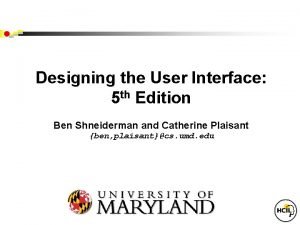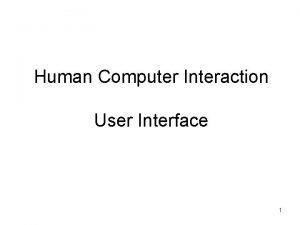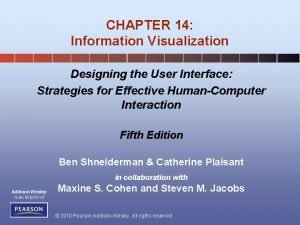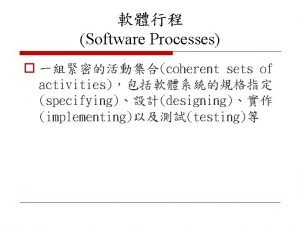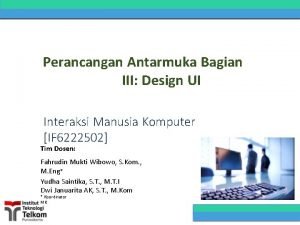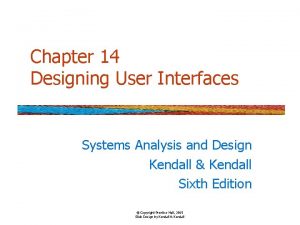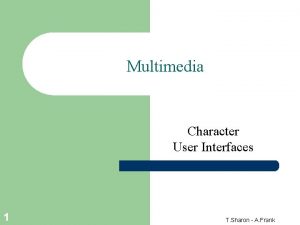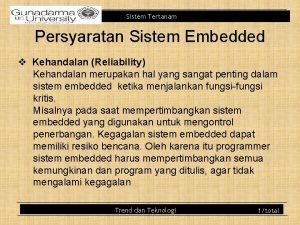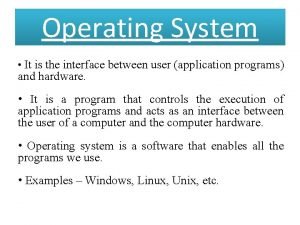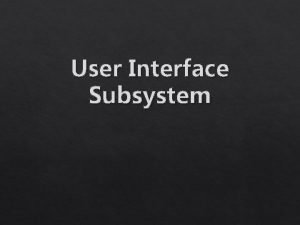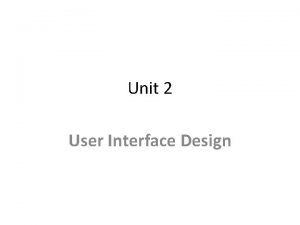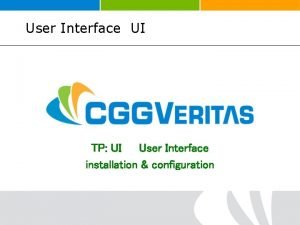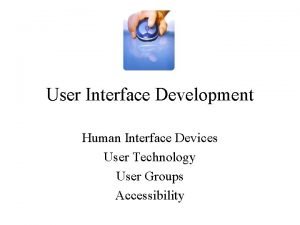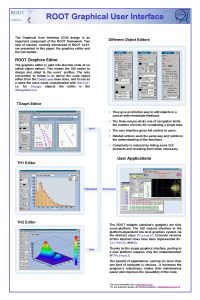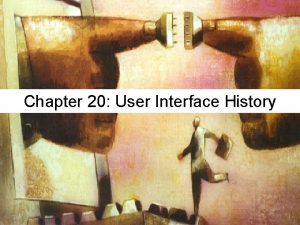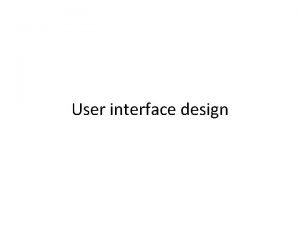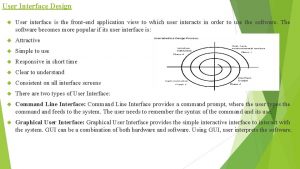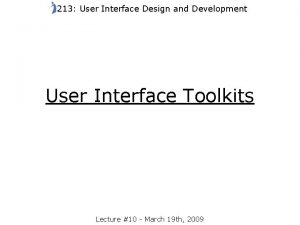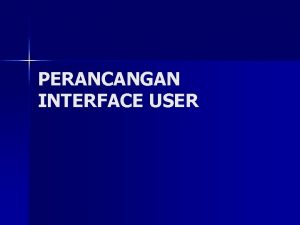An Instructors Outline of Designing the User Interface



































- Slides: 35

An Instructor’s Outline of Designing the User Interface 4 th Edition by Ben Shneiderman & Catherine Plaisant Slides developed by Roger J. Chapman Copyright © 2005, Pearson Education, Inc.

Chapter 11 Design Issues Copyright © 2005, Pearson Education, Inc.

Why do we need to understand users? • Interacting with technology is cognitive • We need to take into account cognitive processes involved and cognitive limitations of users • We can provide knowledge about what users can and cannot be expected to do • Identify and explain the nature and causes of problems users encounter • Supply theories, modelling tools, guidance and methods that can lead to the design of better interactive products Copyright © 2005, Pearson Education, Inc.

Copyright © 2005, Pearson Education, Inc.

Core cognitive aspects • Attention • Perception and recognition • Memory • Reading, speaking and listening • Problem-solving, planning, reasoning and decision-making, learning Copyright © 2005, Pearson Education, Inc.

Design implications for attention • Make information salient when it needs attending to • Use techniques that make things stand out like colour, ordering, spacing, underlining, sequencing and animation • Avoid cluttering the interface - follow the google. com example of crisp, simple design • Avoid using too much because the software allows it Copyright © 2005, Pearson Education, Inc.

An example of over-use of graphics Copyright © 2005, Pearson Education, Inc.

Which is easiest to read and why? What is the time? What is the time? Copyright © 2005, Pearson Education, Inc.

Memory • Involves encoding and recalling knowledge and acting appropriately • We don’t remember everything - involves filtering and processing • Context is important in affecting our memory • We recognize things much better than being able to recall things – The rise of the GUI over command-based interfaces • Better at remembering images than words – The use of icons rather than names Copyright © 2005, Pearson Education, Inc.

The problem with the classic ‘ 7 2’ • George Miller’s theory of how much information people can remember • People’s immediate memory capacity is very limited • Many designers have been led to believe that this is useful finding for interaction design Copyright © 2005, Pearson Education, Inc.

Understanding how interfaces affect users • Expressive interfaces – how the ‘appearance’ of an interface can elicit positive responses • Negative aspects – how computers frustrate users • Anthropomorphism and interface agents – The pros and cons • Designing synthetic characters Copyright © 2005, Pearson Education, Inc.

Affective aspects • HCI has generally been about designing efficient and effective systems • Recently, move towards considering how to design interactive systems to make people respond in certain ways – e. g. to be happy, to be trusting, to learn, to be motivated Copyright © 2005, Pearson Education, Inc.

Expressive interfaces • Color, icons, sounds, graphical elements and animations are used to make the ‘look and feel’ of an interface appealing – Conveys an emotional state • In turn this can affect the usability of an interface – People are prepared to put up with certain aspects of an interface (e. g. slow download rate) if the end result is very appealing and aesthetic Copyright © 2005, Pearson Education, Inc.

Friendly interfaces • Microsoft pioneered friendly interfaces for technophobes - ‘At home with Bob’ software • 3 D metaphors based on familiar places (e. g. living rooms) • Agents in the guise of pets (e. g. bunny, dog) were included to talk to the user – Make users feel more at ease and comfortable Copyright © 2005, Pearson Education, Inc.

User-created expressiveness • Users have created emoticons - compensate for lack of expressiveness in text communication: Happy : ) Sad : < Sick : X Mad >: Very angry >: -( • Also use of icons and shorthand in text and instant messaging has emotional connotations, e. g. I 12 CU 2 NITE Copyright © 2005, Pearson Education, Inc.

User frustration • Many causes: – When an application doesn’t work properly or crashes – When a system doesn’t do what the user wants it to do – When a user’s expectations are not met – When a system does not provide sufficient information to enable the user to know what to do – When error messages pop up that are vague, obtuse or condemning – When the appearance of an interface is garish, noisy, gimmicky or patronizing Copyright © 2005, Pearson Education, Inc.

Expectations for Quality of Service • Introduction – 1960 s: mathematical computation association with computation time – World wide web: means graphics, & network congestion effect response time – Time is precious • Lengthy or unexpected system response time can produce: – Frustration – Annoyance – Eventual anger • Speedy and quickly done work can result in users: – – learning less reading with lower comprehension making more ill-considered decisions committing more data-entry errors Copyright © 2005, Pearson Education, Inc.

Models of response-time impacts • Response time – The number of seconds it takes from the moment users initiate an activity until the computer presents results on the display • User think time – The number of seconds the user thinks before entering the next action Copyright © 2005, Pearson Education, Inc.

Models of response-time impacts • Designers of response times and display rates in HCI must consider: – – – – complex interaction of technical feasibility cost task complexity user expectations speed of task performance error rates error handling procedures Copyright © 2005, Pearson Education, Inc.

Models of response-time impacts • Overall majority of users prefer rapid interactions – Lengthy response times (15 seconds) are detrimental to productivity – Rapid response times (1 second or less) are preferable, but can increase errors for complex tasks Copyright © 2005, Pearson Education, Inc.

Models of response-time impacts • Display Rate – Alphanumeric displays: The speed in characters per second at which characters appear for the user to read – World Wide Web Applications: Display rate may be limited by network transmission speed or server performance • Reading textual information from a screen is a challenging cognitive and perceptual task – Users relax when the screen fills instantly- beyond a speed where someone may feel compelled to keep up Copyright © 2005, Pearson Education, Inc.

Models of response-time impacts • Cognitive human performance would be useful for: – making predictions – designing systems – formulating management policies Copyright © 2005, Pearson Education, Inc.

Models of response-time impacts Limitations of short-term and working memory • Any cognitive model must emerge from an understanding of human problem-solving abilities • Magic number seven - plus or minus two – The average person can rapidly recognize seven chunks of information at a time – This information can be held for 15 to 30 seconds in short-term memory – Size of the chunks depends on the person' s familiarity with the material Copyright © 2005, Pearson Education, Inc.

Models of response-time impacts • Short-term memory and working memory are used in conjunction for processing information and problem solving – Short-term memory processes perceptual input – Working memory generates and implements solutions • People learn to cope with complex problems – develop higher-level concepts using several lower-level concepts brought together into a single chunk • Short term and working memory are highly volatile – Disruptions cause loss of memory – Delays require that memory be refreshed Copyright © 2005, Pearson Education, Inc.

Models of response-time impacts Source of errors • Solutions to problems must be recorded to memory or implemented – Chance of error increases when solutions are recorded • When using an interactive computer system users may formulate plans and have to wait for execution time of each step • Long (1976) found unskilled and skilled typists worked more slowly and made more errors with longer response times – For a given user and task, there is a preferred response time Copyright © 2005, Pearson Education, Inc.

Models of response-time impacts Conditions for optimum problem solving • Longer response time causes uneasiness in the user because the penalty for error increases • Shorter response time may cause the user to fail to comprehend the presented materials • Progress indicators shorten perceived elapsed time and heighten satisfaction: – graphical indicators – blinking messages – numeric seconds left for completion Copyright © 2005, Pearson Education, Inc.

Models of response-time impacts Conditions for optimum problem solving (cont. ) • Rapid task performance, low error rates, and high satisfaction can come from: – Users have adequate knowledge of the objects and actions necessary for the problem-solving task – The solution plan can be carries out without delays – Distractions are eliminated – User anxiety is low – There is feedback about progress toward solution – Errors can be avoided or handled easily Copyright © 2005, Pearson Education, Inc.

Models of response-time impacts Conditions for optimum problem solving (cont. ) • Other conjectures in choosing the optimum interaction speed – Novices may exhibit better performance with slower response time – Novices prefer to work at slower speeds – With little penalty for an error, users prefer to work more quickly – When the task is familiar and easily comprehended, users prefer more rapid action – If users have experienced rapid performance previously, they will expect in future situations Copyright © 2005, Pearson Education, Inc.

Expectations and attitudes Related design issues may clarify the question of acceptable response time – E. g. how long before hearing a dial-tone • Two-second limit (Miller, 1968) appropriate for many tasks • But users have adapted a working style and expectation based on responses within a fraction of a second • People can detect 8% changes in a 2 -4 second response time Response-time choke • A system is slowed down when the load is light and potential performance high • Makes the response time more uniform over time and across users, avoiding expectations that can’t always be met Copyright © 2005, Pearson Education, Inc.

Expectations and attitudes Response time across web sites varies • It effects user interest and quality assessment Three things influence response-time: • Previous experiences • The individual's tolerance for delays • Task complexity Copyright © 2005, Pearson Education, Inc.

User productivity • Repetitive tasks – Nature of the task has a strong influence on whether changes in response time alter user productivity – Shorter response time means users responds more quickly, but decisions may not be optimal – Goodman and Spence (1981) – reduced response time lead to more productivity – Teal and Rudnecky (1992) – slower response time lead to more accuracy Copyright © 2005, Pearson Education, Inc.

User productivity • Problem solving tasks – Users will adapt their work style to the response time – Users will change their work habits as the response time changes – Grossberg, Wiesen, and Yntema (1976) – the time to solution was invariant with respect to response time Copyright © 2005, Pearson Education, Inc.

User productivity • Summary – Users pick up the pace of the system to work more quickly with shorter response time – Higher throughput of work demands more attention must be paid to minimizing the cost of delay of error recovery Copyright © 2005, Pearson Education, Inc.

Variability • People are willing to pay substantial amounts of money to reduce the variability in their life e. g. insurance • Goodman and Spence (1981) – Subjects took more advantage of fast response time by making their subsequent commands immediately and balancing the time lost in waiting for slower responses • Modest variations in response time (plus or minus 50% of the mean) appear to be tolerable • It may be useful to slow down unexpected fast responses Copyright © 2005, Pearson Education, Inc.

Frustrating experiences • (Ceaparu et al. , 2004) 46% to 53% of users’ time was seen as being wasted • Recommendations include improving the quality of service and changes by the user • Poor quality of service is more difficult in emerging markets and developing nations • User training can help • E-mail a common application, but also a common source of frustration (i. e spam) • Viruses also a problem Copyright © 2005, Pearson Education, Inc.
 Ben shneiderman designing the user interface
Ben shneiderman designing the user interface Dale's cone of experience
Dale's cone of experience Abowd and beale framework example
Abowd and beale framework example Industrial interfaces
Industrial interfaces Interface------------ an interface *
Interface------------ an interface * Interface in java
Interface in java Task conformance in hci
Task conformance in hci Yahoo user interface
Yahoo user interface Interface design in software engineering
Interface design in software engineering Graphical user interface design principles
Graphical user interface design principles Graphical user interface in data structures
Graphical user interface in data structures Visualization in user interface design
Visualization in user interface design Coherent ui a modern user interface
Coherent ui a modern user interface Contoh perancangan antarmuka
Contoh perancangan antarmuka Application software interface
Application software interface User interface design and implementation
User interface design and implementation Interface architecture diagram
Interface architecture diagram User interface and its types
User interface and its types User interface process application block
User interface process application block Quiz interaksi manusia dan komputer
Quiz interaksi manusia dan komputer User interface analysis and design
User interface analysis and design Input and output design
Input and output design Apa pengertian antarmuka pemakai (user interface) ?
Apa pengertian antarmuka pemakai (user interface) ? Python user interface design
Python user interface design Voice user interface
Voice user interface User interface in software engineering
User interface in software engineering User interface design in system analysis and design
User interface design in system analysis and design Character user interface
Character user interface Interface history
Interface history What is xul
What is xul Mengapa sistem embedded harus memiliki kehandalan sistem
Mengapa sistem embedded harus memiliki kehandalan sistem Tangible user interface examples
Tangible user interface examples User interface in os
User interface in os Windows 7 user interface
Windows 7 user interface Backoffice design
Backoffice design Which operating system is a multiuser os developed in 1969
Which operating system is a multiuser os developed in 1969
